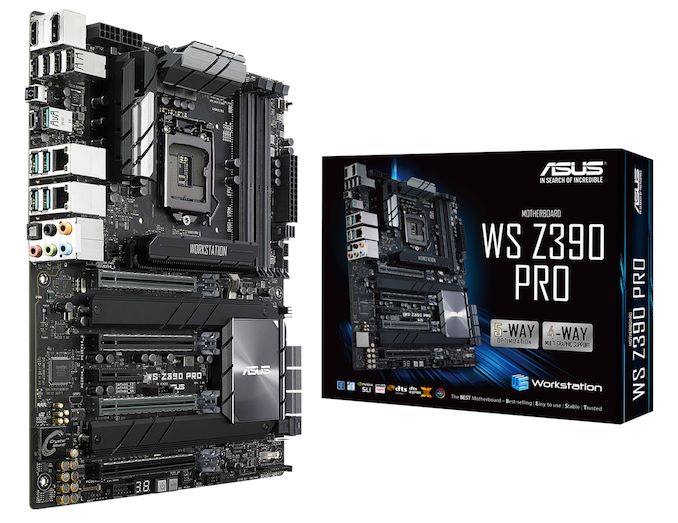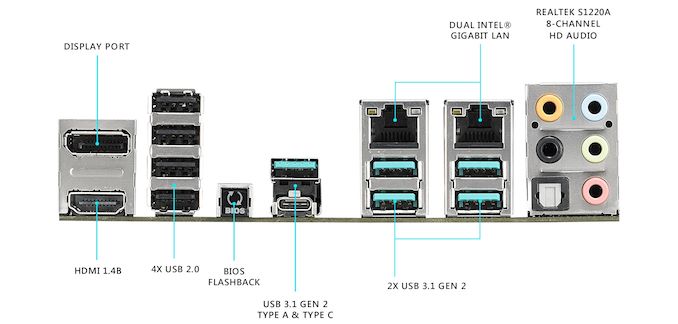Intel Z390 Motherboard Overview: 50+ Motherboards Analyzed
by Ian Cutress & Gavin Bonshor on October 8, 2018 10:53 AM EST- Posted in
- Motherboards
- Intel
- MSI
- Gigabyte
- ASRock
- EVGA
- Asus
- NZXT
- Supermicro
- Z390
ASUS WS Z390 Pro
Outside of the gaming-centric offerings on the new Z390 chipset, the ASUS WS Z390 Pro is one of the most comprehensive with a massive set of specifications and feature-rich list that makes this a very attractive high-end option. Stylistically the board has a subtle black and silver theme throughout with a glossy silver chipset heatsink. The WS stands for workstation and is designed specifically for professional users looking to build a high powered multi-core system with one of the higher end Intel Core i9- 9900K processors. The biggest feature of the WS Z390 Pro is in its ability to run up to four-way SLI thanks to four Safe Slot protected full-length PCIe 3.0 slots. The top two operate with a bandwidth of x16/x16 with two cards installed, x16/x8/x8 with three cards and x8/x8/x8/x8 with four graphics cards. Although the WS Z390 Pro has no PCIe 3.0 x1 slots to speak of, it has a single PCIe 3.0 x4 slot located between the full-length slots.
The storage options of the WS Z390 Pro includes three M.2 PCIe 3.0 slots with two of them having support for SATA drives too; also present is six SATA ports with support for RAID 0, 1, 5 and 10 arrays. The WS Z390 Pro also features two U.2 ports. The board is equipped with four RAM slots with support for DDR4-4266 and a total capacity of up to 64 GB. A total of six 4-pin PWM enabled headers are located on the board and ASUS has included two 8-pin 12 V ATX CPU power inputs for overclockers to make use of.
The WS Z390 Pro focuses less on gaming orientated features and more on professional elements with a Realtek S1200A HD audio codec powered the five 3.5 mm audio jacks and S/PDIF optical output. The rear panel also features dual Intel Gigabit LAN with an Intel I21LM and Intel I210AT Gigabit NIC. A total of ten USB ports are located on the rear panel which is split into five USB 3.1 Gen2 Type-A, one USB 3.1 Gen2 Type-C and four USB 2.0 ports. At the far left-hand side is a DisplayPort and HDMI 2.0b pair of video outputs and the WS Z390 Pro has a handily located BIOS Flashback button on the rear panel too.
As expected the WS Z390 Pro will most certainly be one of the most expensive Z390 ASUS boards at launch, with the pricing currently unknown and looks set to offer prosumers a four-way SLI capable desktop offering from one of the biggest brands in the industry. The USB 3.1 Gen2 integration in the Z390 chipset has been made to great use and the WS Z390 Pro offers the one of the most comprehensively implemented feature-sets on the entirety of the chipset. It's slightly disappointing that there's no 5 G or 10 G Aquantia LAN to be seen and this would have been a much-welcomed feature for workstation users to sink their teeth into.












79 Comments
View All Comments
pawinda8 - Monday, October 15, 2018 - link
Still no mention of any Z390 boards with native Thunderbolt 3 (not AIC)! Has Intel given up on Thunderbolt for the PC world?gavbon - Monday, October 15, 2018 - link
If it's not integrated into the chipset, it's not really native as such. The ASRock Z390 Phantom Gaming-ITX/ac has a Thunderbolt 3 port on the rear panel, but that's the only one I'm afraidHikariWS - Monday, October 15, 2018 - link
Oculus Rift requires 3 USB3 ports and doesn't accept any of them being connected to a hub, they all need to be connected directly into a raw port. I had to buy a dedicated 3GIO USB 3 board that added 6 useful extra ports. In my (yes, old) Gigabyte z87 mobo I also had issues using keyboard and mouse on USB 3 ports inside UEFI and some recovery softwares, so I had to buy a USB 2 mirror to connect them.Because of that, having USB 2 ports on front panel and nice quantity of USB 3 is what most differs mobos for me, given that all other features are nearly the same.
ASUS Z390-A seems to be the best option. It has the important double USB2 ports, 5 USB3 ports and still has HDMI and DP for emergencies.
just4U - Monday, October 15, 2018 - link
I wish MSI had released a "godlike" board for the Ryzen series.ThugEsquire - Tuesday, October 16, 2018 - link
You list the ASRock Z390 Phantom Gaming-ITX/ac above as an ATX board, but it's actually mITX. FYIgavbon - Friday, October 19, 2018 - link
I have gone through every page where the Phantom Gaming-ITX/ac is listed, but I can't see where it says it's an ATX board? Could you please be more specific? Are you viewing on mobile or desktop?Galcobar - Tuesday, October 16, 2018 - link
It would be really helpful to break out one more criteria into a table: Type-C header for case-front ports.Helping a friend put together an i5 system and, knowing he'll keep it for a long time, am trying to get even with peripheral connectors (already has a monitor, so no using that as a hub). It's relatively easy to identify cases with a Type-C port, but that's pointless without a motherboard header. Having to go into each board's page to check is time-consuming.
jjnam - Thursday, April 18, 2019 - link
6 months later and I'm here for EXACTLY this reason. I've gone through probably 50 manuals over the past few days squinting to find this information. What a pain.Synomenon - Thursday, October 18, 2018 - link
So on the ASRock Z390 Phantom Gaming-ITX/ac, is the TB3 port on the rear using up lanes from CPU (making the only 16x slot, 8x only)?If it's not using lanes from the CPU, how will using that TB3 port (say with a USB3.1 Gen2 hub OR TB3 hub) affect all the other ports / IO on the board?
repoman27 - Thursday, October 18, 2018 - link
Going off of what TweakTown published, it's a single-port Intel JHL6240 "Alpine Ridge" controller with a PCI 3.0 x2 connection to the PCH. So it won't affect the PEG lanes from the CPU. I'm amazed it's not Titan Ridge at this point though.